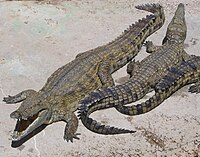
Photo from wikipedia
STUDY OBJECTIVE Insufficient penile skin is common during vaginoplasty for male-to-female transition. This issue may be compensated via a scrotal skin flap, with the drawback of hair growth [1]. In… Click to show full abstract
STUDY OBJECTIVE Insufficient penile skin is common during vaginoplasty for male-to-female transition. This issue may be compensated via a scrotal skin flap, with the drawback of hair growth [1]. In recent studies, Nile tilapia skin was successfully used for surgical management of Mayer-Rokitansky-Küster-Hauser syndrome [2,3] and vaginal stenosis [4,5]. The present study aims to describe a novel technique for primary vaginoplasty in male-to-female gender-affirming surgery using Nile tilapia skin as a biocompatible graft to assure adequate vaginal depth. DESIGN Stepwise demonstration of the procedure with narrated video footage. SETTING Transgender health clinic. INTERVENTIONS A 29-year-old patient with gender dysphoria was referred to our office due to desire for gender-affirming surgery. Physical examination revealed normal male genitalia with a 14 cm long penis. Before surgery, Institutional Review Board approval and written permission from the patient were obtained. After orchiectomy, penile disassembly, perineal dissection, and urethroplasty were performed, a hollow Nile tilapia skin mold was prepared and sutured to the distal edge of the remaining penile skin. This structure was inverted, covering the newly created canal. The neocavity was then filled with a handmade inflatable vaginal mold, held in place by sutures in the labia majora. Finally, labiaplasty and clitoroplasty were conducted. After 7 days, the inflatable mold was removed and use of progressively larger dilators was initiated. After 3 weeks, a neovagina 16 cm long and able to accommodate the width of two fingers was detected. At that time, Nile tilapia skin was completely reabsorbed into the neovaginal mucosa. There were no complications in the early post-surgical period. CONCLUSION Nile tilapia skin, a safe, low cost and easy-to-use biocompatible material, may be an alternative option to scrotal skin grafts for neovaginal augmentation in primary vaginoplasty for male-to-female gender transition. However, further studies are needed to confirm this assertive.
Journal Title: Journal of minimally invasive gynecology
Year Published: 2020
Link to full text (if available)
Share on Social Media: Sign Up to like & get
recommendations!